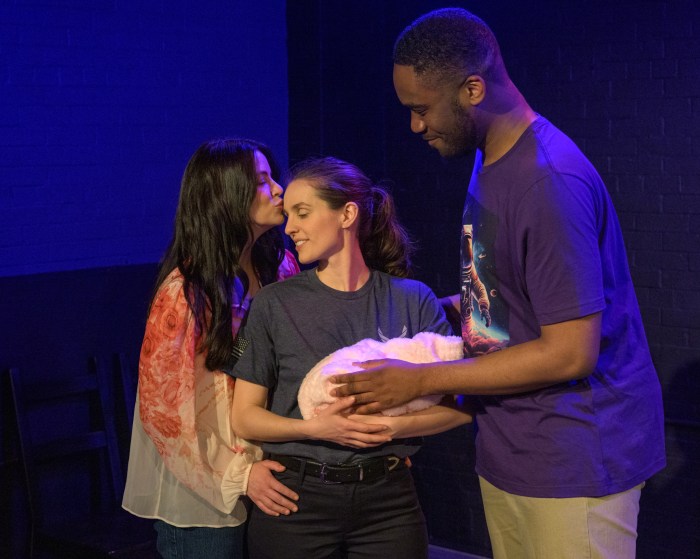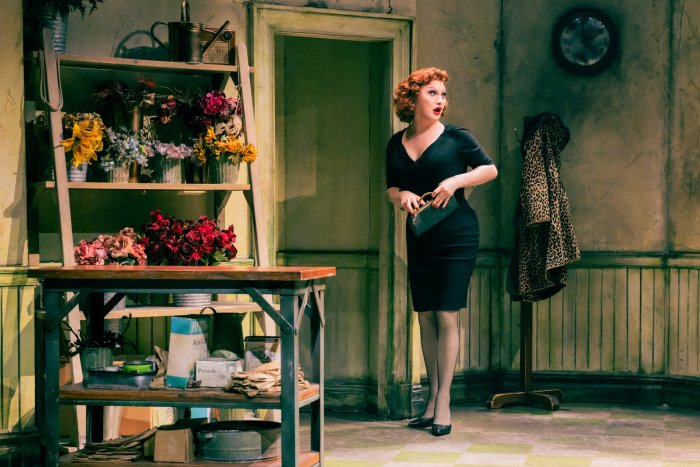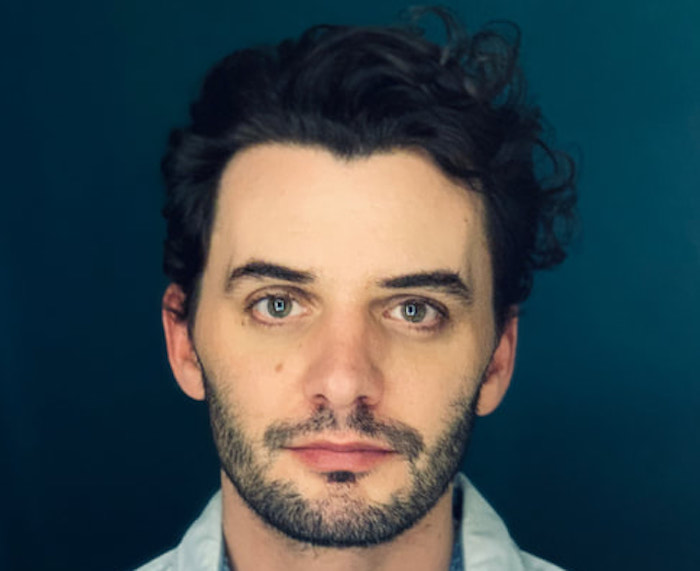“Hair” is a triumph while “Buffalo Gal” struggles to find itself.
By: CHRISTOPHER BYRNE
HAIR
The Public Theater
Delacorte in Central Park
Mid-park at 80th St.
Tue.-Sun. at 8 .p.m.
through Aug. 31
Free; tickets at 212-539-8750
Or at thepublictheater.org
BUFFALO GAL
Primary Stages at 59E59 Theaters
59 East 59th St.
Tue. at 7 p.m.; Wed.-Sat. at 8 p.m.;
Sat. at 2 p.m.; Sun. at 3 p.m.
$60 212- 79-4200
Time is not always kind to musicals. Far too often, as the line from “The Fantasticks” suggests, “what was last night scenic/ may be cynic by today.” In other words, the downfall of so many revivals is that sounds and styles from another era turn quaint or curious with time, and the value of the show may begin and end with nostalgia.
That was, I feared, what was going to happen with the Public Theater's revival of “Hair.”
And indeed the number of middle-aged audience members arriving in Central Park garbed in faux hippie costumes and declaring themselves ready to party like it's 1967 did nothing to allay my anxiety.
Fortunately, for all concerned, the real show was on stage, and this stunning revival surpassed any expectations I might have had, acquiring richness from its history and relevance from its timeliness that give it an unmistakable freshness and a powerful sense of theater.
This intelligent production is a revelation and, for all its power on its own merits, it is most surprising in blowing away the romanticized memories of a show that I suspect few people truly know and emerging as a galvanizing, thought-provoking, and emotionally rich experience. Seeing “Hair” in a full production for the first time, I was taken by the way in which Gerome Ragni and James Rado's book grapples with timeless issues of political crisis, personal identity, and the notion of the self in the context of a dynamic culture.
While we are asked to laugh at the “older generation,” the script does not necessarily make heroes out of the young and presumably more free any more than it vilifies their elders. The young are as flawed and struggling as their parents. Indeed, the first act is largely about the struggle to discover who one is in the context of a changing cultural and political landscape where the traditional definitions of race, gender, sexuality, and belief don't necessarily apply.
In “Hair,” we see the beginning of a cultural disquiet that continues today and has only intensified as polarization dominates so many aspects of our society. That's why the power of this show is far more subtle – and more moving – than just its anti-war message. It's the unavoidable change and terrifying uncertainty that drives the emotional life of this show.
These kids are not just resisting the war on moral principles; they are, not surprisingly, afraid to die. And yet, at some point they have to make choices – and some of those are tragic. Claude, the central character, chooses to be drafted, and he pays the ultimate price. His death is tragic and pointless, and the show ends not with a celebration, but a plea. “Let the Sunshine In” is not a celebration but a cry for us to wake up and see what's happening. It's a cry that resonates in our own time, and the answers are just as elusive.
No wonder “Hair” was greeted with disdain in the late '60s. Not only did it flout the social order, it challenged the traditional structures of theater and transformed Broadway more than four decades ago. Born from the then-nascent Off-Off Broadway movement, “Hair'”s impact is felt in everything from “Spring Awakening” to “Passing Strange” to “[title of show],” to name just three recent productions that can trace their narrative and musical structures to it. We take such shows almost for granted today, but “Hair” changed how we looked at theater as an art form and distinguished it from television and other media.
Yet all of that would be interesting but inherently meaningless if this current production didn't work as engaging theater for today's audience. Diane Paulus has directed the show with passion and attention to the details that gives life to the characters and their world. The characters are written in broad strokes, but Paulus and her company fill in the lines in ways that are honest and affecting.
Scott Pask's unassuming but perfect set simply continues Central Park onto the stage of the Delacorte. Michael Chybowski's lighting is genius. The colors of the psychedelic movement, the influences of Peter Max, and the acid color choices of the pop artists are felt in the lighting that gives a surreal but never outdated look to the stage.
The company is exceptional. Mostly featured as “The Tribe” with individual characters filtering in and out as the story unfolds, there are standout performances by Will Swenson as Berger, the consummate drop-out, Allison Case as Crissy, Andrew Kober as Father/Margaret Mead, and Patina Renea Miller as Dionne. Their fine, strong voices and exuberance carry the show.
Jonathan Groff as Claude struggled for notes and focus at the performance I saw, but he acquired a real power and presence at the end. Caren Lyn Manuel as Sheila has an excellent voice, but her connection to the material didn't feel as solid as the rest of the company.
At the end of the show, audience members are brought down onto the stage to dance to “Let the Sun Shine In.” The stage quickly filled and became a dance party, reminiscent of the end of “Mamma Mia!” It was disconcerting to me, and made me think of preschoolers dancing to the Village People's “YMCA” and wonder if they had really been paying attention to the drama that had just been played out before them. I, for one, was far too moved and emotionally and intellectually smitten to dance.
BUFFALO GAL
You've got to love a backstage comedy. Well, sometimes. A. R. Gurney's “Buffalo Gal,” now at Primary Stages, is amusing and charming but falls flat. The story of a Hollywood actress who, desperate for work, returns to Buffalo to appear in a regional theater production of “The Cherry Orchard,” would seem to be a slam dunk for fun.
There are laughs aplenty as Amanda finds herself a star out of the spotlight and battles with nerves and her larger-than-life personality. Yet Gurney writes himself into a corner, and by midway through the second act, he's had all his fun, and the play grinds to a halt, searching for an ending that can make sense. He never finds it.
Still, there are engaging performances by Susan Sullivan as Amanda the star, Carmen M. Herlihy as Debbie, the intern at the theater, and especially Mark Blum as Dan, the man who was smitten by Amanda when they did shows together as kids. Blum manages a balance between depression, optimism, and puppy love that is beautifully rendered.
Gurney, like Kaufman and Hart before him in “Merrily We Roll Along,” wants to show that the stage is good and movies are, if not bad, then less than. However much we who love theater want to agree, he needs to mount a more convincing argument.


































